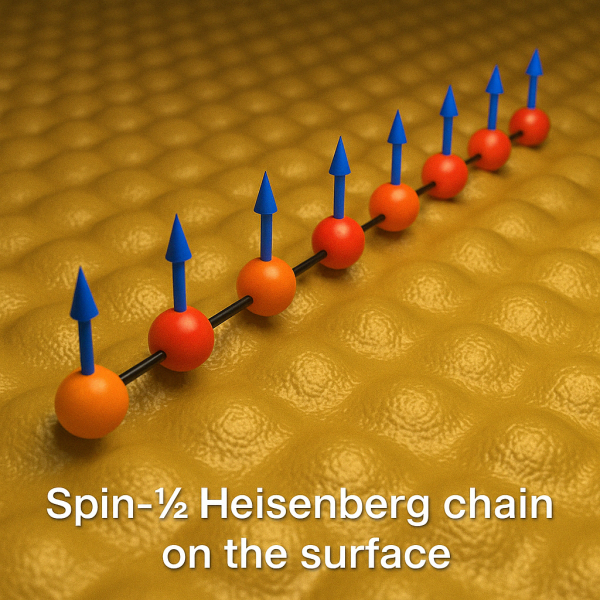Unravelling topological states in quantum spin chains
Experimental realizations of a dimerized spin-½ Heisenberg chain using scanning tunneling microscopy have been reported. By tuning exchange interactions, they explore topological and trivial phases. These findings provide insight into low-dimensional quantum magnetism and offer direct evidence of edge states, advancing the study of symmetry-protected topological phases.
Low-dimensional spin systems have long served as essential models in classical and quantum physics, helping researchers explore complex phenomena such as synchronization and magnetism. Among these, the spin-½ Heisenberg model with dimerized exchange interactions has gained attention for its topological properties, particularly its resemblance to the spin-1 Haldane chain, a system known for exhibiting symmetry-protected topological (SPT) phases. This idea, proposed by F. D. M. Haldane in 1983, played a central role in his 2016 Nobel Prize in Physics.

Figure. Schematic representation of a dimerized spin-½ Heisenberg chain in a topological phase, assembled on a surface. The alternating strong (J₂) and weak (J₁) exchange couplings lead to the emergence of unpaired edge spins, represented at both ends of the chain.
Now, two independent studies—by Wang et al. and Zhao et al.—report experimental realizations of the dimerized spin-½ Heisenberg chain using low-temperature scanning tunneling microscopy (STM). In these systems, two types of exchange couplings (J₁ and J₂) define the magnetic interactions between spins. The model exhibits a gapped spectrum, and its topological or trivial nature depends on the relative strength of these couplings.
Zhao et al. synthesized chains of Clar’s goblets (C₃₈H₁₈) on Au(111) surfaces, each carrying a spin-½. By controlling the chain’s length, parity, and termination using STM tip-induced dehydrogenation, they tuned the system into topological or trivial phases. Inelastic tunneling spectroscopy revealed zero-bias peaks at chain ends in the topological phase, indicating the presence of Kondo-screened edge spins.
Meanwhile, Wang et al. used atomic manipulation to construct spin chains of titanium atoms on MgO surfaces. By adjusting the spacing between atoms, they could control J₁ and J₂, effectively tuning the system through different topological regimes. This method enabled real-time observation of the appearance or disappearance of edge states, depending on the phase.
These two approaches provide direct experimental access to the topological features predicted in dimerized Heisenberg chains. Together, they mark a significant advancement in the manipulation and understanding of spin-based quantum systems, offering a new platform for exploring SPT phases and their associated quantum phenomena.



